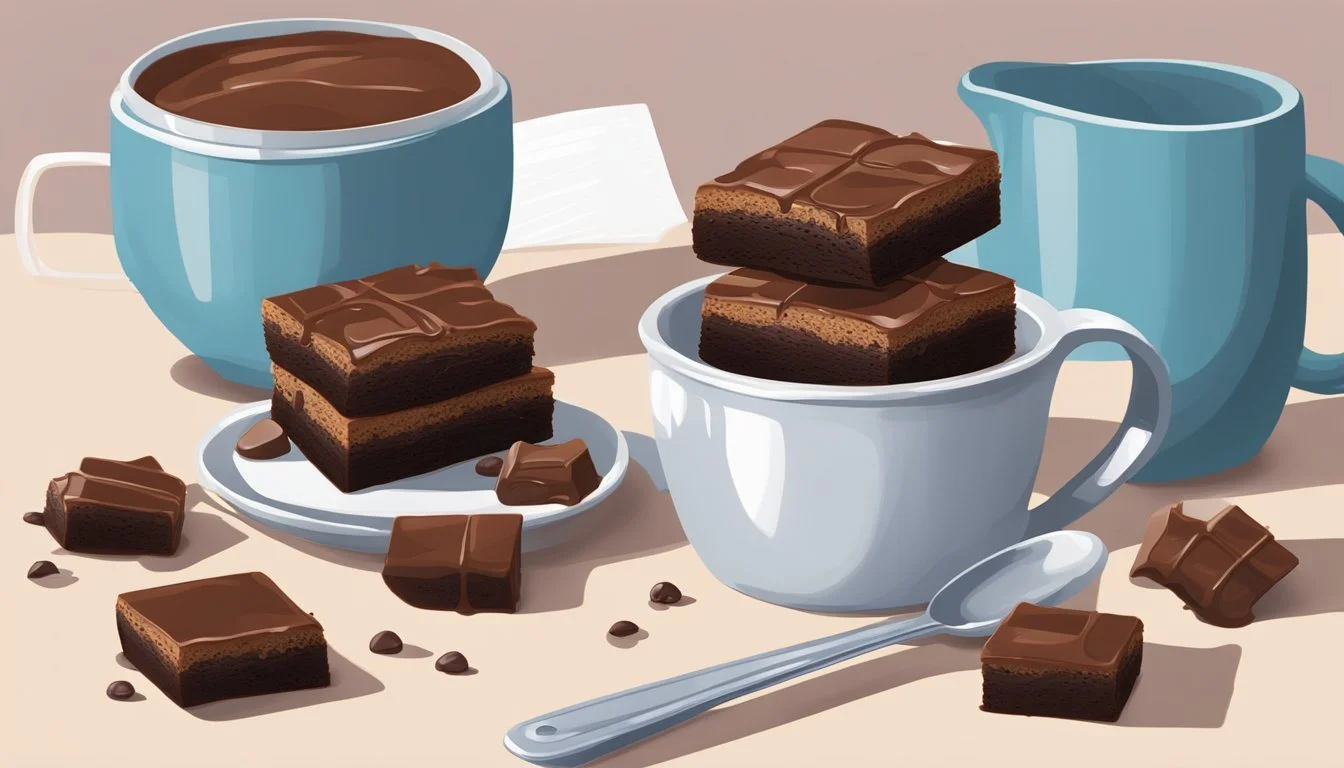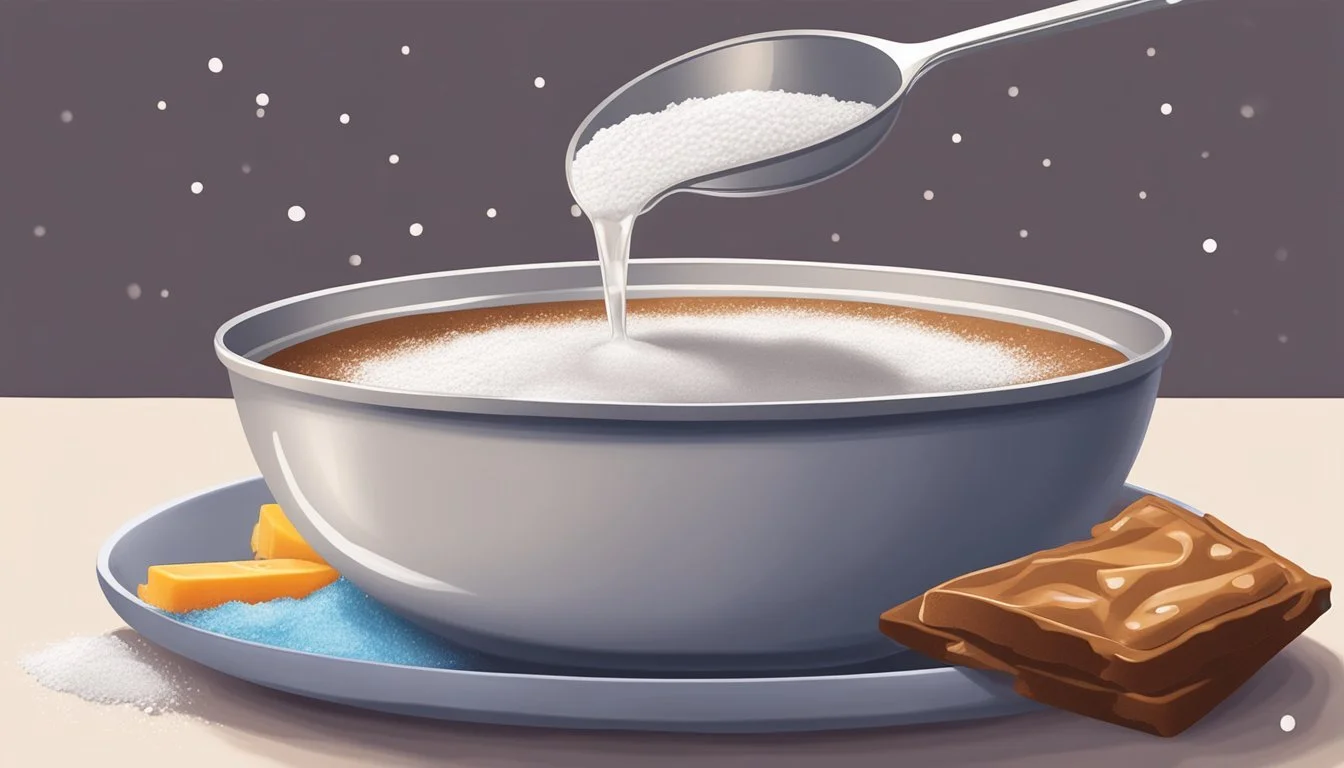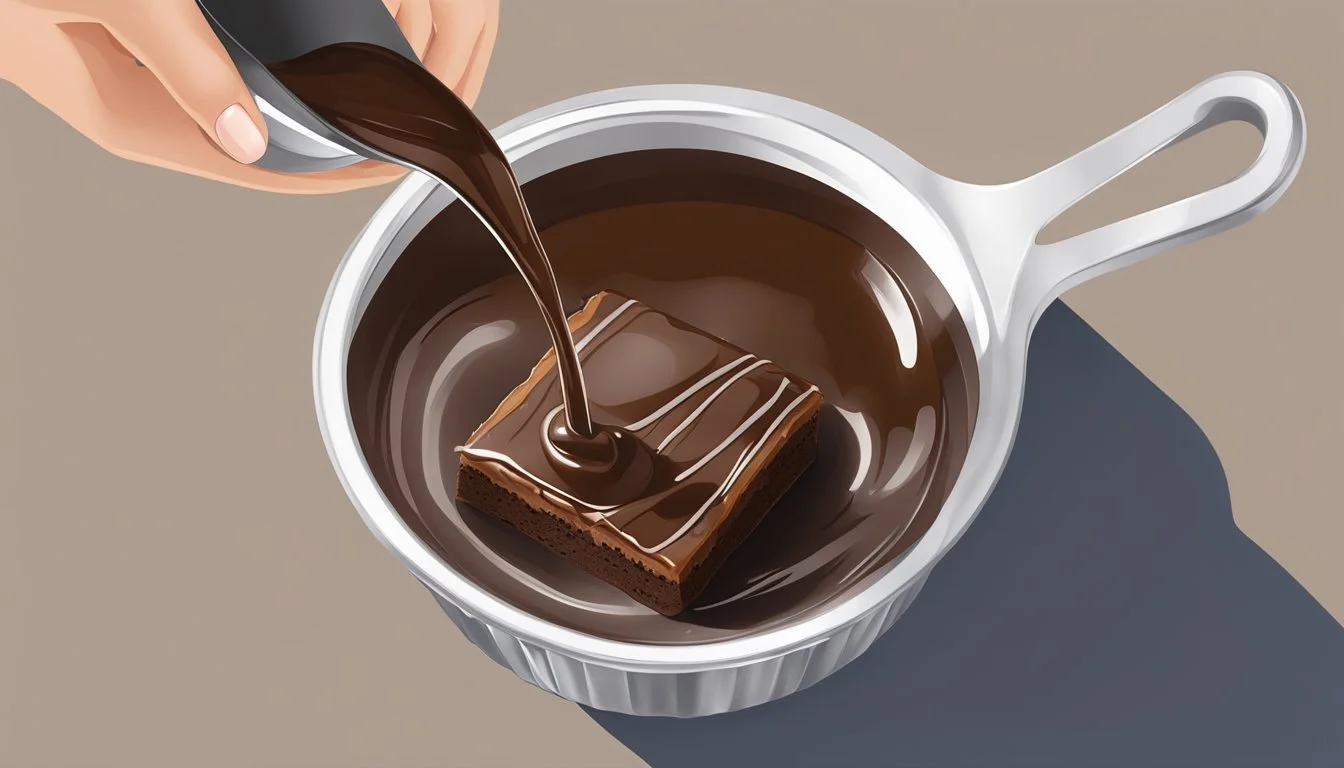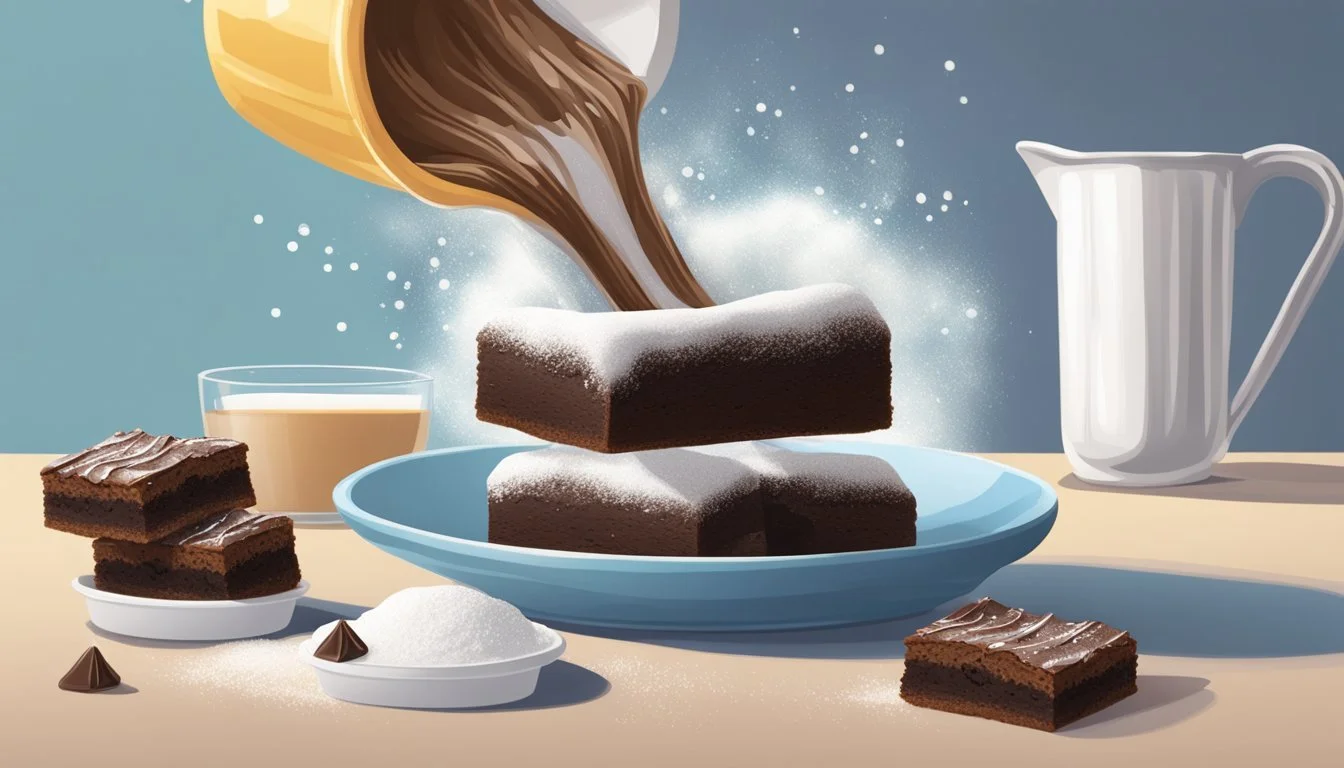How to Measure the Right Amount of Liquid for a Brownie Glaze
Precision Baking Tips
Measuring liquids accurately is essential when making a brownie glaze, as the right proportions can mean the difference between a perfectly smooth topping and one that is too thick or too runny. A glaze can elevate a simple brownie to a decadent dessert by adding both flavor and a visually appealing sheen.
For any brownie glaze recipe, it's important to start with the correct tools. Liquid measuring cups and measuring spoons are key to ensure that ingredients are measured precisely. These tools can help bakers achieve the consistency needed for a smooth and glossy glaze that will complement the dense, rich texture of the brownies.
When preparing the glaze, one must pay attention to the ratio of liquid to sugar, as it affects the final texture and setting capacity of the glaze. A well-prepared glaze should pour easily over the brownies and set with a shiny finish without being absorbed into the dessert. The techniques used in the measuring process contribute significantly to the success of the final product.
Understanding the Basics of Brownie Glaze
Crafting the perfect brownie glaze requires precise measurement and an understanding of key ingredients. Here, the focus is on identifying these essentials and exploring the customary and inventive variations of brownie glazes.
Identifying the Core Ingredients
The foundation of a traditional brownie glaze lies in its core components: butter, powdered sugar, and chocolate (What wine goes well with chocolate?) or cocoa powder. Butter provides a smooth, rich base for the glaze, often melted to combine seamlessly with the powdered sugar, which adds sweetness and structure. Chocolate, in the form of melted pieces or as cocoa powder, imparts the critical chocolate flavor prevalent in brownie glazes. Occasionally, a small pinch of salt is added to balance the sweetness and enhance the overall flavor profile.
Discussing Variations of Brownie Glazes
Variations in brownie glazes introduce an array of flavors and textures. Chocolate glazes can range from dark to milk chocolate, depending on the type of chocolate used. Peanut butter can be added to introduce a creamy, nutty flavor, whereas infusions like mint chocolate offer a refreshing twist. For those seeking a non-chocolate option, a lemon glaze, consisting primarily of powdered sugar and lemon juice, provides a tangy counterpoint to the rich brownie base. These variations allow bakers to tailor the glaze to their particular taste preferences or to complement specific types of brownies.
Preparations Before Making the Glaze
Before embarking on the glaze-making process for brownies, one must have the proper tools and a prepared baking area. These foundational steps are crucial to ensure a smooth and efficient process, leading to a glossy, irresistible glaze atop your brownies.
Selecting the Right Tools and Equipment
For a superb glaze, one needs the following items:
Mixing bowls: Ideally made of glass or metal and of various sizes.
Electric mixer or whisk: These are essential for achieving a smooth texture without lumps.
Measuring cups and spoons: Accurate measures are crucial for a consistent glaze.
Spatulas: Silicone spatulas can scrap every bit of glaze from the bowl to the pan.
Sieve: A fine-mesh sieve can remove any undissolved solids.
Setting up the Baking Area
Ensure the baking area is ready:
Clear workspace: A clutter-free counter allows for an efficient glazing process.
Parchment paper or foil: Lining the pan with parchment paper or foil aids in easy removal of the brownies once cooled and makes cleanup a breeze.
Baking pan: The size of the pan should match the brownie recipe's recommendation as it affects the thickness of the brownies and, subsequently, the glaze coverage.
By carefully preparing one's tools and setup, they pave the way for brownie glazing that is as enjoyable as it is successful.
Creating the Perfect Brownie Base
The foundation of delectable brownies lies in the selection of premium ingredients and the mastery of specific baking techniques to achieve a fudgy texture. The quality of ingredients and baking nuances can elevate a simple brownie to a gourmet level.
Choosing Quality Ingredients
Eggs and Flour: The structural integrity of brownies hinges on eggs and flour. For the richest texture, it's important to use fresh, organic eggs and all-purpose flour. The eggs should be at room temperature to ensure an even mixture.
Sugar: A brownie's sweetness and texture are affected by the type and amount of sugar used. Granulated sugar is typically employed, lending a pleasant sweetness and contributing to the chewy outer crust.
Unsalted Butter: When making brownies, it’s preferable to use unsalted butter, which allows bakers to control the amount of salt in the recipe. It should be melted and cooled slightly before use to prevent affecting the eggs adversely.
Quality Matters: Ingredients should be as fresh and organic as possible to ensure the best flavor.
Baking Tips for a Fudgy Texture
Don’t Over Bake: To keep brownies fudgy rather than cakey, one should be careful not to overbake. The brownies are done when a toothpick inserted in the center comes out with a few moist crumbs.
Baking Powder: If a lighter, cake-like texture is preferred, one can add a small amount of baking powder to the recipe. However, for dense and fudgy brownies, baking powder is typically omitted.
Oven Temperature: Preheating the oven to the correct temperature is vital. An oven thermometer can ensure accuracy, as internal oven temperatures can deviate from the setting.
Pan Preparation: A suitably lined and greased pan will not only prevent sticking but will also contribute to even heat distribution.
By adhering to these quality ingredient choices and baking strategies, bakers can generate brownies with a perfectly fudgy texture that delights the palate.
Mixing and Measuring Techniques
In baking, the precision of mixing and measuring ingredients is crucial for achieving the desired texture and consistency. Specific techniques ensure the glaze for brownies is smooth and even.
Achieving Consistent Glaze Thickness
To attain a uniform glaze consistency, one must measure liquids meticulously. A kitchen scale is the most accurate for measuring quantities like water or milk that contribute to the glaze's fluidity. When measuring liquid, they place a bowl on the scale, tare it to zero, and pour the liquid until the correct weight is achieved. They ensure the scale is set to the appropriate unit of ounces or milliliters depending on the recipe.
For thicker liquids or syrups, a clear measuring cup is used. After pouring the liquid to the desired mark, they check at eye level to ensure the meniscus, the slight curve at the liquid's surface, aligns with the measurement marking. This step is vital to prevent excess liquid from altering the glaze's thickness.
For dry ingredients such as sugar or cocoa powder that affect the glaze's consistency, they spoon the ingredient into a measuring cup until heaping, then level it off with a straight edge. This achieves a consistent measure and prevents the glaze from becoming too thin or thick.
Incorporating Flavors and Add-ins
To enhance the glaze with flavors, such as lemon zest or vanilla extract, precise measurements are important. For liquid extracts, they use measuring spoons, filling to the brim to ensure accuracy. Flavorings are potent, so adherence to the recipe is key to achieving the intended taste.
For small quantities of dry additives like lemon zest or chocolate chips, they also use measuring spoons or small scales. The texture of the glaze can be adjusted by finely grating zest or finely chopping chocolate chips before mixing them in. Careful folding of these ingredients ensures even distribution without compromising the glaze's texture.
Applying the Glaze
Applying the glaze to brownies is an art that enhances flavor and appearance. Precision in the application ensures an even distribution and adherence of the glaze to the surface of the brownies.
Ensuring Even Distribution
To achieve an even coat of glaze, one should allow the brownies to cool completely. Starting with a smooth, cooled surface prevents the glaze from becoming uneven or absorbing into the warm brownie. They can use a variety of tools but angled spatulas are particularly effective for spreading the glaze evenly across the top. The user should pour the glaze in the center of the brownie and gently push it towards the edges with the spatula, ensuring consistent coverage.
Timely Application for Best Results
The timing of glaze application is crucial. Once the brownies have cooled and the glaze is ready — ideally at a pourable consistency — they should apply it immediately. For a thinner glaze, the inclusion of fresh lemon juice can add a slight tang and make the glaze more fluid, easing the spreading process. Application should be swift to prevent the glaze from thickening. If they desire to add any toppings, they should sprinkle them on while the glaze is still wet to ensure they adhere properly.
Storing and Serving Brownies
The longevity and taste of brownies are heavily influenced by proper storage, while serving them effectively enhances their appeal for various occasions.
Tips for Keeping Brownies Fresh
To maintain the freshness of brownies, proper storage is paramount. Wrapping them tightly in plastic wrap prevents air exposure, which can lead to dryness. For additional protection, one can also use aluminum foil. Once wrapped, placing the brownies in an airtight container ensures further prevention from air and moisture, which are the main culprits of staleness. These treats can be stored at room temperature for up to 3-4 days.
For longer storage, brownies can be kept fresh in the fridge for about a week. However, the optimal choice for an extended period is the freezer. Brownies can be frozen for up to 3 months. When freezing, it is vital to separate the layers with parchment paper to prevent them from sticking together and making sure they are in an airtight container or freezer bag to avoid freezer burn.
Serving Suggestions for Different Occasions
For bake sales or casual gatherings, brownies can be served as individual bars. This allows for easy handling and portion control, making them an ideal treat for such versatile events.
During holidays, presentation is key. Serving brownies on a festive platter or integrating them into a dessert buffet can make them stand out. They can be cut into various shapes using cookie cutters for thematic flair, such as hearts for Valentine's Day or trees for Christmas.
To serve brownies at formal events, consider plating them with a drizzle of complementary sauce or a dusting of powdered sugar to add a touch of elegance. Pairing the brownies with a matching beverage, like coffee or dessert wine, can enhance the overall tasting experience for guests.
Common Mistakes and Solutions
When preparing a brownie glaze, precision in measuring liquids is crucial for achieving the right consistency. A perfect glaze should coat the brownies with a lustrous sheen, enhancing flavor without being overly runny or excessively thick.
Troubleshooting a Runny or Thick Glaze
To address a glaze that is too runny, cooks may consider:
Adding more powdered sugar: Incorporate small amounts of powdered sugar to the glaze, mixing thoroughly after each addition until reaching the desired thickness.
Chilling the glaze: Place the glaze in the refrigerator to set slightly, which can improve its consistency for a better coating on the brownies.
Conversely, if the glaze is too thick, one might:
Add liquid sparingly: Incorporate more of the liquid ingredient, such as milk or water, a teaspoon at a time, stirring well until the glaze becomes pourable.
Warm the glaze gently: Heating the glaze slightly can make it more fluid, but be cautious to avoid overheating, which could lead to separation.
Avoiding Overbaking Brownies
To prevent overbaking brownies, which can affect the glaze's adherence and texture, chefs should:
Use a toothpick: Insert a toothpick into the center of the brownies a few minutes before the recipe's suggested baking time. If it comes out with a few moist crumbs attached, the brownies are done.
Monitor the oven temperature: Overbaking can occur if the oven runs hot. Use an oven thermometer to verify the actual temperature and adjust accordingly.
By meticulously measuring ingredients and applying these troubleshooting techniques, one should be able to achieve a glaze with a consistency that complements the brownies while avoiding common issues such as overbaking.
Advanced Techniques and Expert Advice
When crafting the perfect brownie glaze, understanding advanced techniques and leveraging expert advice can make the difference between a good dessert and a great one. From achieving the ideal consistency to infusing flavors that complement the brownie base, precision and creativity are paramount.
Creating Artisanal Brownie Varieties
Artisans know that the thickness of the glaze can transform an ordinary brownie into a gourmet experience. For a rich chocolate glaze, one should measure the liquid ingredients with precision—a digital scale can provide more accurate readings than a measuring cup. A scale ensures that the chocolate's intensity is not diminished by too much liquid. Consistency is key; the glaze should coat the back of a spoon without dripping off too quickly.
When experimenting with variations, like adding fruit purees or extracts to craft from scratch glazes, keeping the base glaze's ratio intact is crucial. For a tangy lemon glaze, one might incorporate fresh lemon juice and zest. Incremental additions of these ingredients allow for a controlled balance of tartness without compromising the glaze's texture.
Ingredient Chocolate Glaze Lemon Glaze Base Liquid (e.g., cream) 1/4 cup 1/4 cup Chocolate or Lemon Flavor 1/2 cup melted chocolate 2 Tbsp lemon juice Sweetener (e.g., sugar, honey) 2 Tbsp 2 Tbsp Thickening Agent (e.g., corn syrup) 1 Tbsp 1 Tbsp
Innovative Ways to Enhance Flavor
Flavor enhancement in glazes reaches beyond just adding more of the main ingredient. Experts suggest using high-quality extracts or zests to add depth without altering the glaze's texture. A homemade vanilla extract or a pinch of sea salt can complement a chocolate flavor, elevating the overall taste profile. For a lemon flavor, pairing lemon extract with a touch of vanilla can round out the tanginess, resulting in a more sophisticated glaze.
To infuse a glaze with specialty flavors without additional liquid, one might resort to culinary powders or spice infusions. Unsweetened cocoa powder can intensify a chocolate glaze without thinning it out. Similarly, dehydrated lemon zest powder can boost the lemony punch in a lemon glaze without adding excess moisture.
Flavor Enhancers:
Vanilla extract: enhances both chocolate and lemon glazes.
Sea salt: boosts the richness of chocolate.
Cocoa powder: deepens chocolate flavor.
Lemon zest: adds zest to lemon glazes, enhancing the tangy profile.
In summary, both artisans and casual bakers can achieve expert-level glazes through precise measurement, gradual incorporation of flavors, and strategic use of enhancers. With these practices, one can assure that their brownies provide not just a treat for the taste buds but a testament to the craft of baking.









